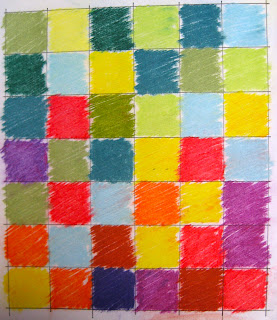Saturation can also be called a colour’s intensity and it refers to the relative purity of a colour. We can also think of it in terms of week and strong or dull and glowing. The more the colour resembles the clear, fully illuminated colours reflected in a prism, the more saturated it is. The lighter of tw colours is not necessarily the more more saturated one. In the following two pairs of colours first ist he lighter one (yellow) and than is the darker one (green) less saturated.
When I add white to a pure colour it will be bleached, lightened, robbed of its intensity. These colours are often referred as tints or pastels.Saturation can be done on different ways:
- Adding black to a pure colour results in deepening shades.
- Mixing pure colours with already saturated colours will result in saturated colours. The most direct and powerful way to rob a colour of ist purity is to mix it with ist complementary colour from the opposite side of the colour wheel.
- Mixing the three primary colours together should theoretically result in a perfectly neutral gray – provided that the starting colours the perfect primary ones.
 |
On this picture you can see the tints and the shades of some pure colours and on the right their values (marked through the dots).
|
If you’re not so familiar with saturation I suggest to try to mix a five(nine)-step saturation scale:
- Prepare a horizontal row of five (nine) adjoining squares of the same size. (e.g: 1 x 1 inch)
- Fill the first square with a pure colour.
- With white and black paint mix a gray that is equal in value to your chosen pure colour.
- Paint the last (fifth or ninth) square with this gray.
- Using the pure colour and the gray you’ve mixed, create a dulled version which should be about halfway between those two. (pay attention, the mixing proportions are not necessarily 50-50%!) Paint the middle square with it.
- Now mix a halfway dulled version between the pure colour in the first square and the somewhat dulled one in the third(fifth) square and than repeat it with the colours in the third (fifth) and in the fifth (ninth) square.
- If you choosed to make a nine step graduation, you have to go on filling out the squares nr.2, 4, 6, 8, mixing always the two colours on their both sides, creating a halfway saturation in between them.
A colour can be pure or more or less saturated. So what’s the big deal about it?
The answer is a bit similar to what we saw at the value.
Again I prepared three grids:
- One with a pure yellow, a neutral gray that has the same value as the yellow and a series of different saturations of these two in between.
- Second grid with only little saturated yellows and grays
- Third with nearly pure or very strongly saturated yellows in it.
If you have the time, regard them and write down your impressions in form of adjectives again. Try to collect adjectives with a positive and negative meaning (like serene and dull).
The first arrangement is quite powerful, dynamic, lively with tension in it. Could express agression maybe.
The second seems calm, quiet, more unified, less tension, almost subduded, boring.
The third is tense, vibrant, unruly, could work „hyperactive“.
Beautiful examples of inherent light are Ad Reinhardt’s abstract paintings:
I will stop it here and if you’ve followed my post, take your time to reflect and sort out how the hue, the value and the saturation could help you to support your design. I will sum it up in my next post – along with some examples – and again we can compare notes.






















